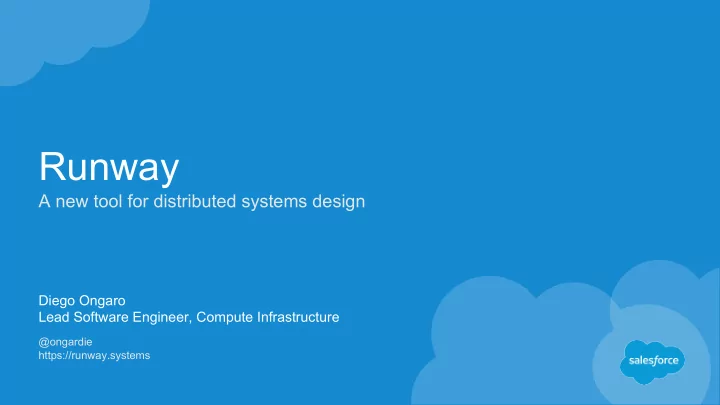

Runway A new tool for distributed systems design Diego Ongaro Lead Software Engineer, Compute Infrastructure @ongardie https://runway.systems
Outline 1. Why we need new tools for distributed systems design 2. Overview and demo of Runway 3. Building a Runway model
Distributed Systems Are Hard ● Concurrency and message delays ● Failures, failures during failures ● Many possible interleavings of events ● Little visibility, poor debugging environments
Raft Background / Difficult Bug Raft: fault-tolerant consensus algorithm Difficult design bug: Used in many examples in this talk Quick summary: 1. Use majority voting to elect a leader 2. Leader replicates its log to followers
Typical Approaches Find Design Issues Too Late Code reviews Unit tests These are good techniques for implementation errors System tests ● Localized: easy to fix Randomized tests, fuzzing, Too expensive for design errors Jepsen ● May require large changes Benchmarks ● May cause unforeseen consequences Metrics Let’s find the right design sooner... Dark launches Bug reports
Design Phase Communication: Evaluation: Goals ● Build intuition quickly ● Simplicity ● Unambiguous ● Correctness ● Reviewable: discuss major issues and ● Performance consider alternatives ● Availability Commonly used today: State of the art: ● Visualization (animation) Tools ● Specification ● Model checking ● Simulation
Design Tools Use System Models A model is a representation of a system that captures its essential concepts and omits irrelevant details. Visualization Specification Model checking Simulation
A Tour of Runway
Runway Overview Specify, simulate, visualize, and check system models graphs, data randomized model simulator execution (spec) visualization interaction S2:recv (error) model (animation) S3:proc checker S1:send Integrated into one tool: write one model, get many benefits
Runway Demo Too many bananas, elevators, and Raft
Runway Integration Independent tools: create independent models TLA+ JS Rust pseudo ● Write similar models for different tools ● Change the design: revise them all 500 LOC 300 LOC 550 LOC 150 LOC Runway: reuse the same model ● Lower cost, additional benefit ⇒ create models sooner ● More likely to find modeling bugs Specification, simulation, and model checking all benefit from visualization
Building a Runway Model
Developing a Model specification Idealized steps: 1. Sketch view by hand 2. Define types, state variables visualization 3. Create view based on sketch aids with view 4. Write invariants debugging 5. Write transition rules Tip: set convenient starting state
Runway’s Specification Language ● Specification is code ● Define starting state, transition rules, and invariants ○ Labeled Transition System ● Rules encode behavior + failures ● Applying a rule is atomic (one at a time) ● A rule is active if applying it would change the state ● If multiple rules are active, system decides ○ Simulator: random choice ○ Model checker: walk the tree
Example: Too Many Bananas (1) Type and variable declarations, invariant type-safe variant: can’t access unless ReturningFromStore
Example: Too Many Bananas (2) Transition rule no state changed: inactive until readset changes
It’s About Time Developers: each server tries to approximate “the global clock” Physicists: Ha! Blah blah blah, blah, blah! Blah blah blah blah. Blah! Want some safety properties to hold even if clocks misbehave Need time to describe availability and performance Runway’s current approach: global clock, conditionally true server.timeoutAt <= clock
Summary ● Let’s apply tools to help us design distributed systems ● Modeling helps focus our attention on concepts, leaving out unimportant details ● Runway combines spec, model checking, simulation, and interactive visualization ● Go view the models, build your own, and help develop Runway
solve design problems in the design phase https://runway.systems
Recommend
More recommend